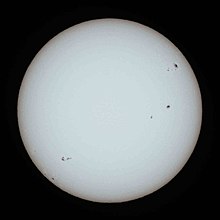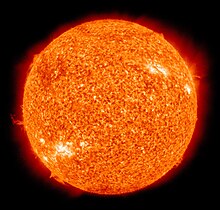
Back Амра Abkhazian Mata uroe ACE Тыгъэ ADY Son Afrikaans Sonne ALS ፀሐይ Amharic Cidal AMI Sol AN Sunne ANG Ura ANN
 | |
 False-color photo of the Sun as seen in ultraviolet light (wavelength of 30.4 nm) | |
| Observation data | |
|---|---|
| Mean distance from Earth | 1 au ≈ 1.496×108 km[1] 8 min 19 s at light speed |
| Visual brightness (V) | −26.74[2] |
| Absolute magnitude | 4.83[2] |
| Spectral classification | G2V[3] |
| Metallicity | Z = 0.0122[4] |
| Angular size | 31.6–32.7 minutes of arc[5] |
| Adjectives | Solar |
| Orbital characteristics | |
| Mean distance from Milky Way core | ≈ 2.7×1017 km 27,200 light-years |
| Galactic period | (2.25–2.50)×108 yr |
| Velocity | ≈ 220 km/s (orbit around the center of the Milky Way) ≈ 20 km/s (relative to average velocity of other stars in stellar neighborhood) ≈ 370 km/s[6] (relative to the cosmic microwave background) |
| Physical characteristics | |
| Equatorial radius | 695,700 km,[7] 696,342 km[8] 109 × Earth[9] |
| Equatorial circumference | 4.379×106 km[9] 109 × Earth[9] |
| Flattening | 9×10−6 |
| Surface area | 6.09×1012 km2[9] 12,000 × Earth[9] |
| Volume | 1.41×1018 km3[9] 1,300,000 × Earth |
| Mass | 1.9885×1030 kg[2] 333,000 × Earth[2] |
| Average density | 1.408 g/cm3[2][9][10] 0.255 × Earth[2][9] |
| Center density (modeled) | 162.2 g/cm3[2] 12.4 × Earth |
| Equatorial surface gravity | 274 m/s2[2] 28 × Earth[9] |
| Moment of inertia factor | 0.070[2] (estimate) |
| Escape velocity (from the surface) | 617.7 km/s[9] 55 × Earth[9] |
| Temperature | Center (modeled): 1.57×107 K[2] Photosphere (effective): 5,778 K[2] Corona: ≈ 5×106 K |
| Luminosity (Lsol) | 3.828×1026 W[2] ≈ 3.75×1028 lm ≈ 98 lm/W efficacy |
| Color (B-V) | 0.63 |
| Mean radiance (Isol) | 2.009×107 W·m−2·sr−1 |
| Age | ≈ 4.6 billion years[11][12] |
| Rotation characteristics | |
| Obliquity | 7.25°[2] (to the ecliptic) 67.23° (to the galactic plane) |
| Right ascension of North pole[13] | 286.13° 19 h 4 min 30 s |
| Declination of North pole | +63.87° 63° 52' North |
| Sidereal rotation period (at equator) | 25.05 d[2] |
| (at 16° latitude) | 25.38 d[2] 25 d 9 h 7 min 12 s[13] |
| (at poles) | 34.4 d[2] |
| Rotation velocity (at equator) | 7.189×103 km/h[9] |
| Photospheric composition (by mass) | |
| Hydrogen | 73.46%[14] |
| Helium | 24.85% |
| Oxygen | 0.77% |
| Carbon | 0.29% |
| Iron | 0.16% |
| Neon | 0.12% |
| Nitrogen | 0.09% |
| Silicon | 0.07% |
| Magnesium | 0.05% |
| Sulfur | 0.04% |

The Sun, also known as Sol, is a star at the center of the solar system. It is a white star that gives off different types of energy such as infrared energy (heat), ultraviolet light, radio waves and light. It also gives off a stream of particles, which reaches Earth as "solar wind". The source of all this energy is nuclear fusion. Nuclear fusion is the reaction in the star which turns hydrogen into helium and makes huge amounts of energy. It is a nearly perfect ball of hot plasma.
The Sun looks yellow to people on Earth, but it is really white. This happens because the air around the Earth scatters sunlight. The blue and green colors in the sunlight spread out more than the red and yellow colors. Because of this, the light that reaches our eyes is mostly red and yellow, making the Sun appear yellow. If we were in space, where there is no air to scatter the light, we would see that the Sun is actually white.
The Sun is a star like many others in our Milky Way galaxy. The Sun is a type of star called a G-type main-sequence star based on its spectral class.[15]
The Sun is about 4.5 billion years old.
The Sun is about a hundred times as wide as the Earth. It has a mass of 1.9891×1030 kg. This is 333,000 times the mass of the Earth. 1.3 million Earths can fit inside the Sun.[16] The Sun fuses about 600 million tons of hydrogen into helium every second.
The Sun is the main source of energy for the Earth. This energy is made deep inside the Sun in a process called nuclear fusion. Four hydrogen atoms are fused together to make one helium atom. Some of the leftover matter turns into energy. This is the same way energy is released in a hydrogen bomb.
It can take between 10,000 and 170,000 years for the energy in the core of the Sun to escape.
- ↑ Pitjeva, E. V.; Standish, E. M. (2009). "Proposals for the masses of the three largest asteroids, the Moon-Earth mass ratio and the Astronomical Unit". Celestial Mechanics and Dynamical Astronomy. 103 (4): 365–372. Bibcode:2009CeMDA.103..365P. doi:10.1007/s10569-009-9203-8. ISSN 1572-9478. S2CID 121374703.
- ↑ 2.00 2.01 2.02 2.03 2.04 2.05 2.06 2.07 2.08 2.09 2.10 2.11 2.12 2.13 2.14 2.15 Williams, D.R. (1 July 2013). "Sun Fact Sheet". NASA Goddard Space Flight Center. Archived from the original on 15 July 2010. Retrieved 12 August 2013.
- ↑ Zombeck, Martin V. (1990). Handbook of Space Astronomy and Astrophysics 2nd edition. Cambridge University Press.
- ↑ Asplund, M.; Grevesse, N.; Sauval, A.J. (2006). "The new solar abundances – Part I: the observations". Communications in Asteroseismology. 147: 76–79. Bibcode:2006CoAst.147...76A. doi:10.1553/cia147s76. ISSN 1021-2043.
- ↑ "Eclipse 99: Frequently Asked Questions". NASA. Archived from the original on 27 May 2010. Retrieved 24 October 2010.
- ↑ Hinshaw, G.; et al. (2009). "Five-year Wilkinson Microwave Anisotropy Probe observations: data processing, sky maps, and basic results". The Astrophysical Journal Supplement Series. 180 (2): 225–245. arXiv:0803.0732. Bibcode:2009ApJS..180..225H. doi:10.1088/0067-0049/180/2/225. S2CID 3629998.
- ↑ Mamajek, E.E.; Prsa, A.; Torres, G.; et, al. (2015), "IAU 2015 Resolution B3 on Recommended Nominal Conversion Constants for Selected Solar and Planetary Properties", arXiv:1510.07674 [astro-ph.SR]
- ↑ Emilio, Marcelo; Kuhn, Jeff R.; Bush, Rock I.; Scholl, Isabelle F. (2012), "Measuring the Solar Radius from Space during the 2003 and 2006 Mercury Transits", The Astrophysical Journal, 750 (2): 135, arXiv:1203.4898, Bibcode:2012ApJ...750..135E, doi:10.1088/0004-637X/750/2/135, S2CID 119255559
- ↑ 9.00 9.01 9.02 9.03 9.04 9.05 9.06 9.07 9.08 9.09 9.10 9.11 "Solar System Exploration: Planets: Sun: Facts & Figures". NASA. Archived from the original on 2 January 2008.
- ↑ Ko, M. (1999). Elert, G. (ed.). "Density of the Sun". The Physics Factbook.
- ↑ Bonanno, A.; Schlattl, H.; Paternò, L. (2002). "The age of the Sun and the relativistic corrections in the EOS". Astronomy and Astrophysics. 390 (3): 1115–1118. arXiv:astro-ph/0204331. Bibcode:2002A&A...390.1115B. doi:10.1051/0004-6361:20020749. S2CID 119436299.
- ↑ Connelly, JN; Bizzarro, M; Krot, AN; Nordlund, Å; Wielandt, D; Ivanova, MA (2 November 2012). "The Absolute Chronology and Thermal Processing of Solids in the Solar Protoplanetary Disk". Science. 338 (6107): 651–655. Bibcode:2012Sci...338..651C. doi:10.1126/science.1226919. PMID 23118187. S2CID 21965292. Retrieved 17 March 2014.(registration required)
- ↑ 13.0 13.1 Seidelmann, P.K.; et al. (2000). "Report Of The IAU/IAG Working Group On Cartographic Coordinates And Rotational Elements Of The Planets And Satellites: 2000". Archived from the original on 12 May 2020. Retrieved 22 March 2006.
- ↑ "The Sun's Vital Statistics". Stanford Solar Center. Retrieved 29 July 2008. Citing Eddy, J. (1979). A New Sun: The Solar Results From Skylab. NASA. p. 37. NASA SP-402.
- ↑ Connelly, J. N.; Bizzarro, M.; Krot, A. N.; Nordlund, A.; Wielandt, D.; Ivanova, M. A. (2012-11-02). "The absolute chronology and thermal processing of solids in the Solar protoplanetary Dpdisk". Science. 338 (6107): 651–655. Bibcode:2012Sci...338..651C. doi:10.1126/science.1226919. ISSN 0036-8075. PMID 23118187. S2CID 21965292.
- ↑ Bonanno, A.; Schlattl, H.; Paternò, L. (2002). "The age of the Sun and the relativistic corrections in the EOS". Astronomy & Astrophysics. 390 (3): 1115–1118. arXiv:astro-ph/0204331. Bibcode:2002A&A...390.1115B. doi:10.1051/0004-6361:20020749. ISSN 0004-6361. S2CID 119436299.